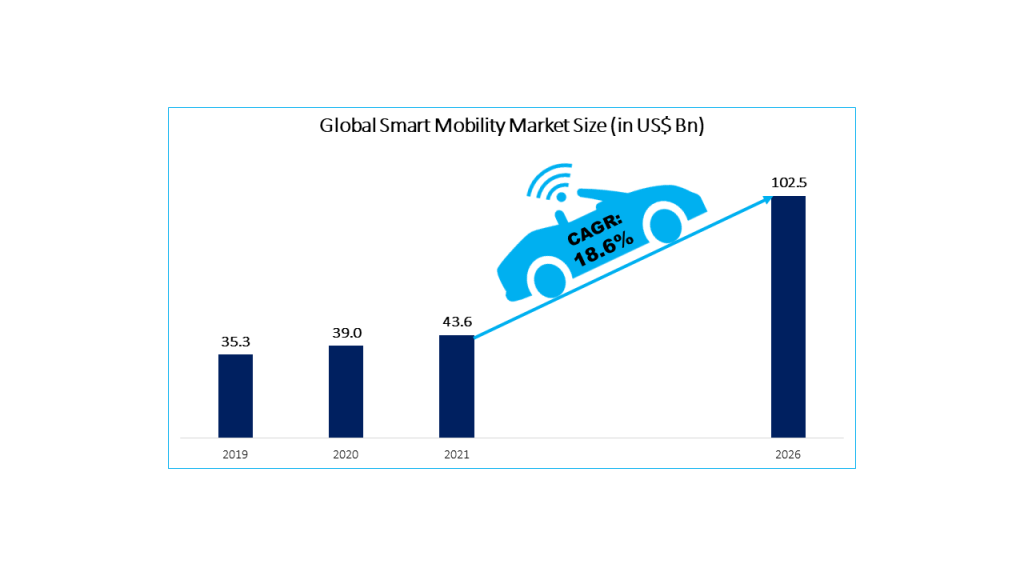Market Overview
The automotive industry has experienced tremendous growth because of developments across connected cars, autonomous vehicles, and electric vehicles. All these technological developments result in mobility solutions that are simple, effective, and dependable. Mobility has become more convenient and cost-effective as the automotive industry has grown. According to McKinsey, cars are increasingly becoming software on wheels, and the race toward unlocking the value potential from connectivity is also underway.
Smart mobility integrates and utilises advanced technologies to make transportation more efficient and effective, providing more comfort and a better user experience. Also, it helps the environment making it greener and cleaner. In this new age of transportation, new business models are inspired by the sharing economy and disruptive technologies. The arrival of on-demand ride services, real-time ride-sharing services, carpooling programs, car subscription models, different lanes for public transportation, etc., is changing how people commute.
The global smart mobility market is growing due to various government initiatives for smart cities and the rise in on-demand transportation services. The low internet penetration rate in developing regions and data security threats are expected to restrain the market’s growth. However, the improved performance of autonomous vehicles and intelligent transportation systems is expected to provide some of the best opportunities for market growth.
The global smart mobility market is expected to grow to US$ 102.5 Billion by 2026 from US$ 43.6 Billion, at a CAGR of more than 18.5% during the period 2021-26

Emerging Applications
Mobility has become as much about bits and bytes as physical infrastructure. In smart cities, shared mobility, autonomous vehicles, the Internet of Things, and advanced analytics enable people and goods to move faster, safer, cheaper, and cleaner. Some of the emerging market trends in the smart mobility market are:
- Consumption-based Taxes and Tolls: Few countries are already working towards charging taxes and tolls based on the distance covered or road usage in place of the amount of fuel purchased, and several toll booths have crossed.
- Better Transit Experience: Most automakers collaborate with content providers to offer endless entertainment and a better customer experience to commuters using public transport.
- On-Demand Car Pooling: In metro cities, carpooling will be a key solution to reduce traffic congestion as it will provide more options for non-drivers.
- Self-Driving Cars: Autonomous or self-driving cars will increase road capacity and take the ride-sharing experience to the next level.
- Parking Management: Real-time traffic data will enable commuters to find the parking spot and save time and fuel.
- Traffic Management: Efficient use of advanced technologies, including IoT and Data Analytics, will help decently manage the traffic and enable real-time reporting of any on-road incidents.
- Usage-based Insurance (UBI): Insurance premiums will be decided based on driving behaviour and use of vehicles.
- Contactless Payment System: NFC and IoT technologies enable commuters to make contactless payments without cards or cash.
Smart Mobility and Smart Cities
These days, tech-savvy millennials prefer rental rides over having their vehicles, and they usually opt for ride-sharing services while commuting to work or somewhere else. The major driving factor for this population is the ease of use, where they need to open an app and avail of the service based on their requirements and convenience.
Smart mobility is associated mostly with Smart Cities, as the major focus of a smart city has been to use technologies for enhancing transportation and mobility services. An ideal smart city should understand the benefits of advancing transportation and providing better citizen services. Smart mobility can be one of the important aspects of a smart city project where collaboration would happen between government/public and private entities. Smart mobility would solve various problems related to urbanisation, including dense population, ineffective transportation, increasing pollution, and increasing demand for fuel hence increasing transportation costs.
Smart mobility can be a tool to achieve sustained mobility and the environment. For a sustained environment, it is obvious that Smart mobility will reduce the use of private vehicles. This will enable various governments worldwide to achieve their target of creating smart cities with a sustainable future.
Mobility As A Service (MAAS)
Mobility as a Service integrates various transport services into a single mobility service accessible on demand. This new way of mobility is not taking us away from our traditional forms of transportation. Still, it is quite the opposite, and MaaS enhances the capacity and efficiency of existing public transportation. MaaS can succeed only if implemented through cooperation between public and private entities. Many cities are already being explored globally, mostly in Europe, to test the alignment of the existing infrastructure and advanced mobility services for better services and optimisation for commuters.
The MaaS market is expected to grow exponentially due to technological developments such as big data and analytics, IoT, mobile, AI/ML, Blockchain, etc. Also, increasing internet and smartphone penetration and social distancing or contactless transactions due to the COVID-19 pandemic drive the demand for MaaS. However, the need for higher capital investments, lack of awareness among commuters in developing countries and lack of technical experts may restrain the market’s growth.
Our Perspective
The mobility space will keep evolving at a rapid pace worldwide. Technology is the enabler to take that forward, with technological developments in connected, autonomous, and EV segments. Smart cities worldwide will also expand and require smart mobility services for a quicker and more efficient commute. Though various government regulations will limit the adoption of autonomous vehicles, most will drive the growth of EV adoption to reduce carbon footprints.
Mobility-as-a-Service will be the next trending area in the coming years. With the increasing adoption of emerging technologies, smart mobility services offer promising new possibilities for making more efficient use of existing infrastructure. Many cities are now looking to offer shared mobility services through scooters, cabs, and even public transport, including buses, trains, and metros. Smart mobility will help reduce traffic congestion, lower accident rates, improve air quality, and shrink the urban footprint required for parking.






